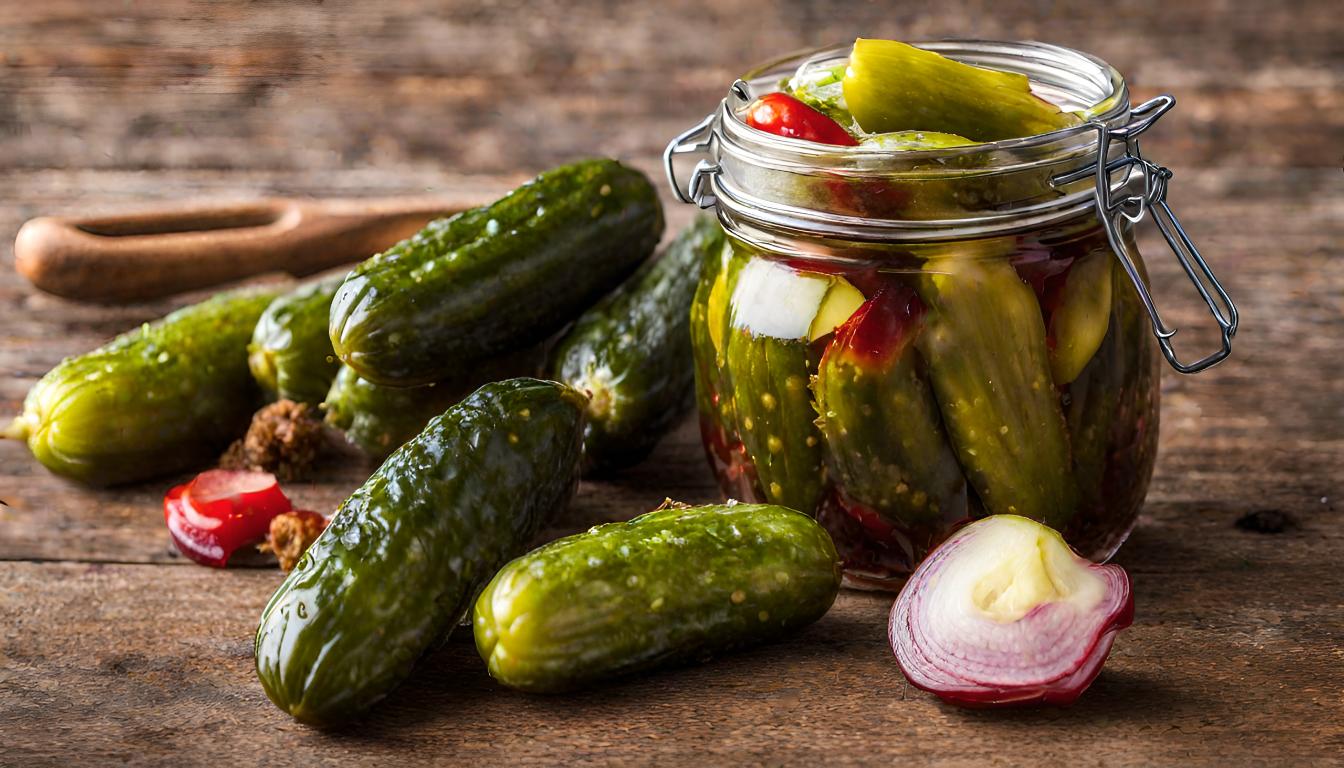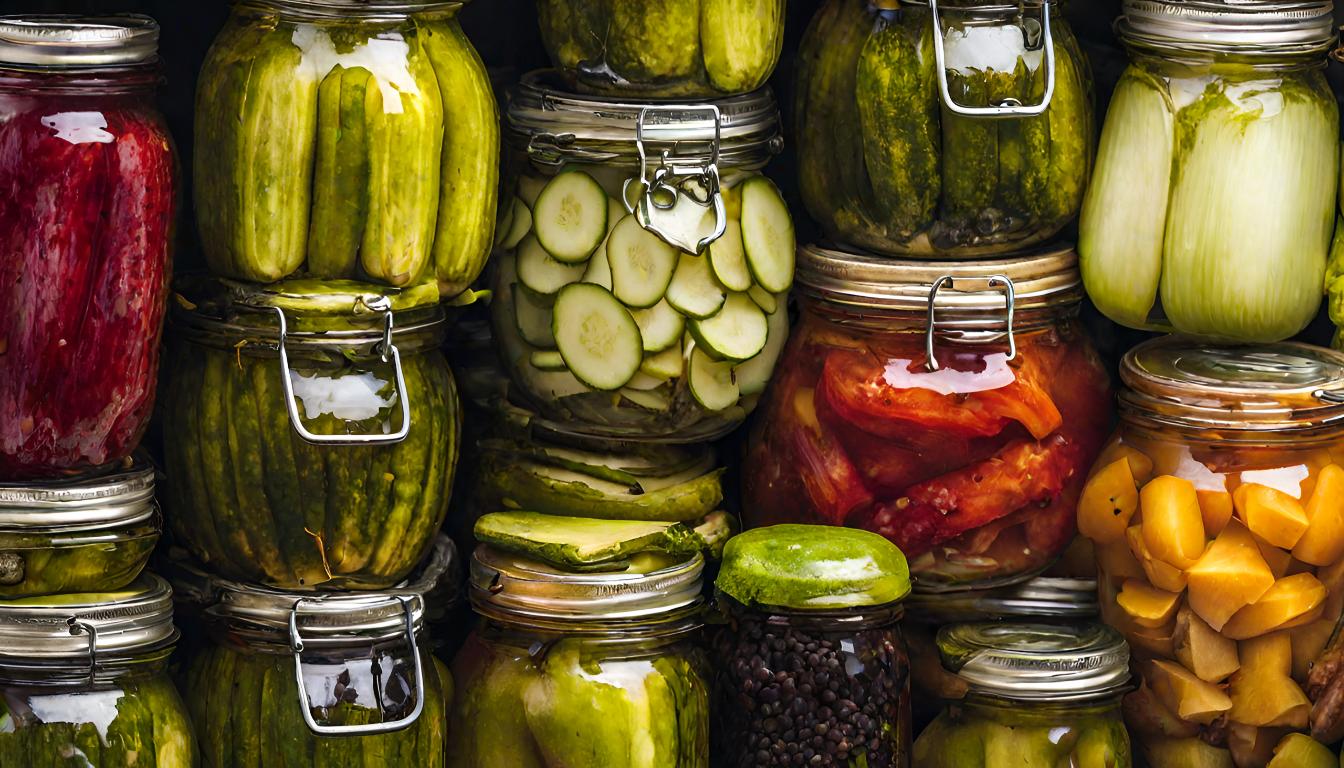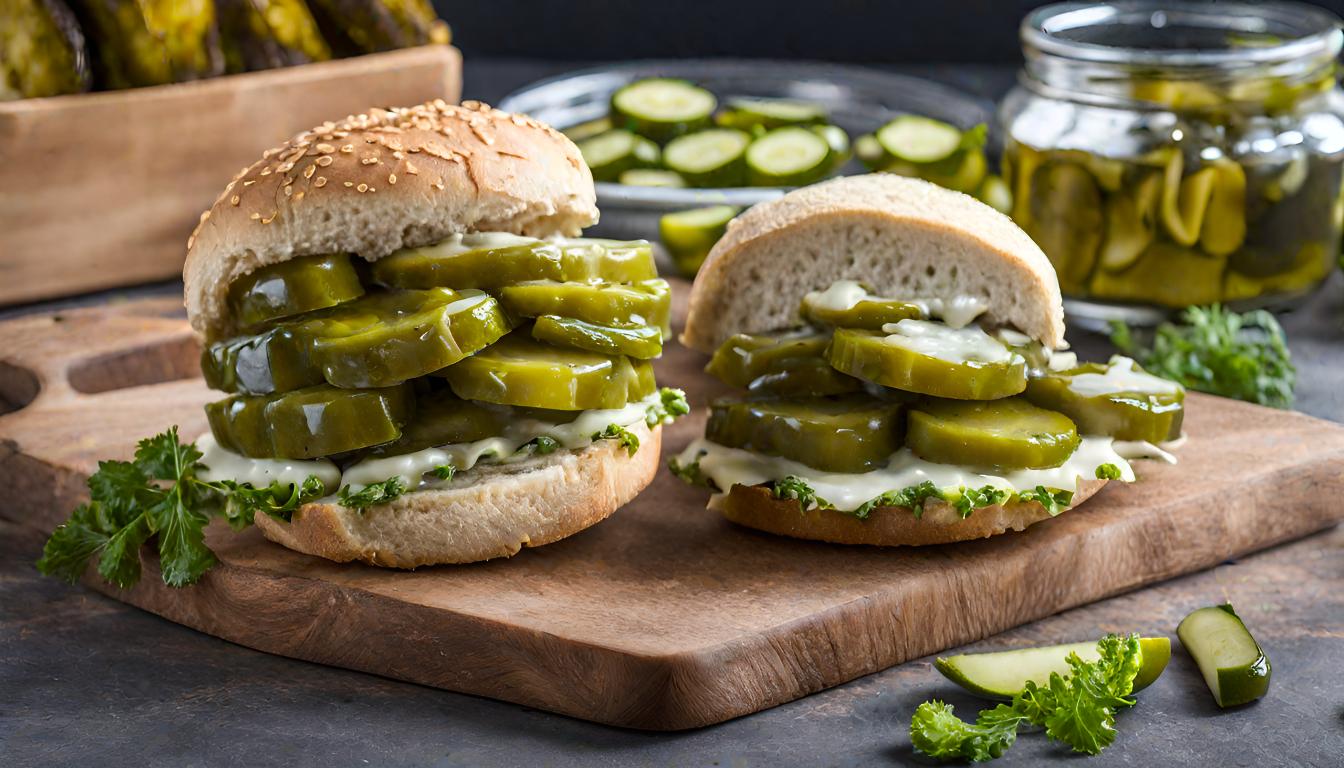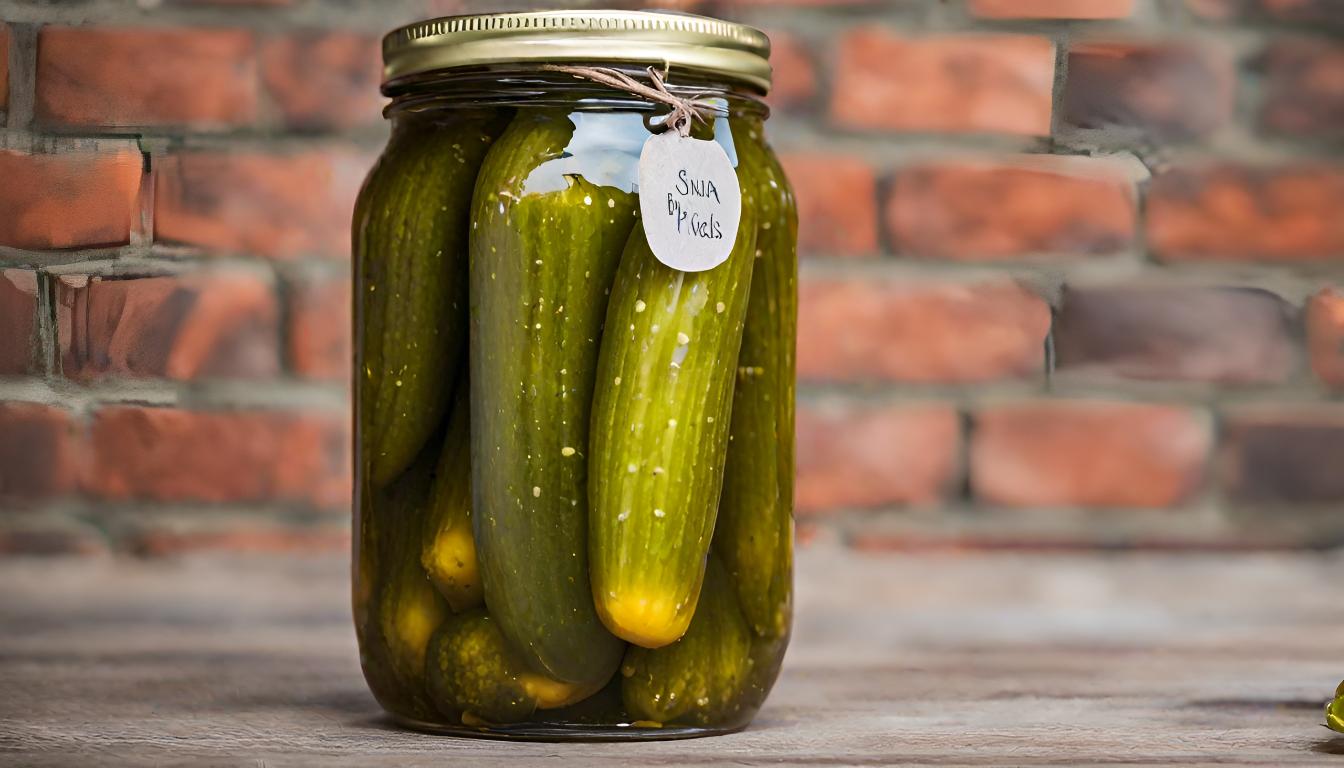In the vast and varied world of pickles, stand out for their unique taste and versatility. Contrary to their tangy dill counterparts, sweet pickles, on the other hand, introduce a delightful sweetness to the table. Consequently, this makes them a preferred choice for many…Classic bread and butter slices to tiny, crunchy gherkins can elevate meals or be tasty snacks. This article explores the world of these pickles, delving into their history, types, production methods, and culinary uses. We’ll cover health benefits, nutrition, plus selection and storage tips. Whether a long-time fan or new, join our flavorful journey.

Understanding the Appeal
The Basics
Historical Background
Cucumber pickling started in ancient Mesopotamia around 2400 B.C. The sweet variety appeared in the 16th century, when Europe got sugar.They became popular in 19th-century America, especially with bread and butter pickles during the Great Depression. These were a cost-effective way to preserve cucumbers and add a sweet, tangy flavor to meals. The history a testament to human ingenuity in food preservation and flavor enhancement, making them a beloved part of culinary traditions around the world.
Continue following as we dive into the various types, explore how to prepare them, and uncover the countless ways to enjoy them in dishes or as delightful treats on their own.
Exploring the Varieties
They come in an array of shapes, sizes, and flavors, each bringing its unique twist to the pickle family. Let’s dive into some of the most popular types and discover what sets them apart.
Bread and Butter Pickles
Perhaps the most iconic of the varieties, thinly sliced cucumbers and onions soak in a sweet and tangy brine, seasoned with mustard seeds and turmeric, giving them a distinct yellow hue. The name suggests their traditional use as a sandwich staple, offering a perfect sweet crunch between slices of bread and butter. These pickles strike a balance between sweetness and tanginess, making them a versatile addition to burgers, sandwiches, and even as a snack straight from the jar.
Gherkins
Commonly known as cornichons in French, manufacturers pickle these small cucumbers in a uniquely sweet and vinegary brine. Consequently, their crunchy texture and subtly sweet taste distinguish them.. Furthermore, spices such as dill, cloves, and tarragon serve to further enhance their flavor profile.Gherkins are a popular garnish for charcuterie boards, a flavorful addition to salads, and a delightful accompaniment to pâtés and cheeses. Their small size and crunchy bite make them a favorite among enthusiasts.
Sweet Relish
Sweet relish transforms the concept of sweet pickles into a spreadable condiment. It features diced cucumbers, onions, and sometimes bell peppers, all blended into a brine that marries sweet and tangy flavors. This mixture creates a versatile topping or ingredient that enhances a variety of dishes. It’s a staple topping for hot dogs, sausages, and burgers, adding a burst of sweetness and texture. You can also use sweet relish in salad dressings, tartar sauce, and potato salads, demonstrating its versatility in the kitchen.
Comparing Sweet Pickles to Other Types

Sweet pickles, known for their sugary brine and crisp texture, contrast with other types like dill pickles, which boast a sour and herbaceous flavor. Sour pickles, another variant, ferment in a saltwater brine without vinegar, providing a complex, tangy taste. Spicy pickles, on the other hand, incorporate hot peppers or chili flakes for a fiery kick. Each type of pickle caters to different taste preferences, but sweet pickles, with their unique blend of sugar, vinegar, and spices, offer a delightful sweetness that complements a wide range of dishes.
In the next section, we’ll uncover the secrets behind making sweet pickles, from the key ingredients that contribute to their sweetness to the pickling process that transforms ordinary cucumbers into crunchy, flavorful delights.
Culinary Uses of Sweet Pickles
Sweet pickles are not just a delight to eat on their own; they’re also a versatile ingredient that can enhance a variety of dishes. Their unique blend of sweetness and tanginess can add depth and complexity to recipes, making them a favorite among chefs and home cooks alike.
Popular Recipes Featuring Sweet Pickles
- Sweet Pickle Potato Salad: A classic potato salad gets a sweet twist with chopped sweet pickles, adding a crunchy texture and a balance of flavors that’s hard to resist. Combine with mayonnaise, mustard, and fresh herbs for a refreshing side dish.
- Bread and Butter Pickle Sandwiches: Layer slices of bread and butter pickles on your favorite sandwich for an instant upgrade. Their sweet and tangy flavor pairs well with deli meats, cheese, and even peanut butter for a unique treat.
- Sweet Pickle Relish Hot Dogs: Elevate your hot dog game by topping them with sweet pickle relish. The relish’s sweetness complements the savory flavors of the hot dog and bun, creating a perfect bite every time.
- Sweet Pickle Tartar Sauce: Chop sweet pickles into fine pieces and mix them into tartar sauce for an extra layer of flavor. Serve with fried fish or seafood for a delicious combination.
- Cheese and Pickle Skewers: For a quick and easy appetizer, skewer cubes of cheese with sweet gherkins or bread and butter pickle slices. The sweetness of the pickles contrasts beautifully with the creaminess of the cheese.
DIY Sweet Pickle Making at Home

Making sweet pickles at home is a rewarding process that allows you to customize the flavors to your liking. Here’s a simple method to get you started:
- Ingredients:
- Cucumbers, sliced or whole
- White vinegar
- Water
- Sugar
- Salt
- Mustard seeds, celery seeds, and turmeric (for bread and butter pickles)
- Fresh dill and garlic (optional, for a different flavor profile)
- Directions:
- In a large pot, combine vinegar, water, sugar, and salt. Bring to a boil, stirring until the sugar and salt dissolve.
- Add the spices to the brine and simmer for a few minutes to infuse the flavors.
- Pack the cucumbers into sterilized jars, leaving some space at the top.
- Pour the hot brine over the cucumbers, ensuring they are completely covered.
- Seal the jars and let them cool to room temperature before refrigerating.
- For the best flavor, let the pickles sit in the refrigerator for at least a week before enjoying.
Homemade sweet pickles can be tailored to your taste preferences by adjusting the amount of sugar, the type of vinegar, or the spices used. Experimenting with different combinations can lead to your perfect pickle recipe.
Sweet pickles add a delightful sweetness and crunch to any meal, making them a staple in kitchens around the world. Whether you’re enjoying them straight from the jar or incorporating them into your favorite dishes, sweet pickles are sure to bring a smile to your face.
Health Benefits and Nutritional Info

While sweet pickles delight the palate with their unique taste, they also offer nutritional benefits that contribute to a healthy diet. Understanding the nutritional value and health benefits of sweet pickles can help you incorporate them into your meals in a way that supports your wellbeing.
Nutritional Value of Sweet Pickles
Sweet pickles are low in calories, making them a guilt-free snack for those monitoring their calorie intake. A typical serving of sweet pickles (about one ounce or two tablespoons of chopped pickles) contains:
- Approximately 20-30 calories
- Less than 1 gram of protein
- No fat
- Around 7-10 grams of carbohydrates, primarily from sugars
- 0.5-1 gram of dietary fiber
- Small amounts of vitamins and minerals, such as vitamin K, vitamin A, and iron
The exact nutritional content can vary based on the brand and recipe used for the pickles, especially the amount of sugar added during the pickling process.
Health Benefits of Including Sweet Pickles in Your Diet
- Hydration: Sweet pickles contain a high water content, which can help keep you hydrated, especially during hot weather or after exercise.
- Digestive Health: The vinegar in sweet pickles can promote healthy digestion by stimulating the production of stomach acid. Additionally, the fiber content in cucumbers can aid in regular bowel movements.
- Antioxidant Properties: Cucumbers and the spices used in pickling, such as turmeric and mustard seeds, contain antioxidants that can protect your cells from damage by free radicals.
- Low in Fat: Sweet pickles are virtually fat-free, making them a healthy addition to diets that aim to reduce fat intake.
- Satisfying Snack: The combination of sweetness and crunch makes sweet pickles a satisfying snack that can curb cravings and prevent overeating.
However, it’s important to consume sweet pickles in moderation due to their high sugar and sodium content. Excessive consumption can lead to increased calorie intake and potential health issues, such as high blood pressure. As with any food, balance and moderation are key.
Incorporating sweet pickles into your diet can add flavor and nutrition to your meals. Whether enjoyed as a snack or used as an ingredient in recipes, sweet pickles can be a part of a balanced and healthy diet.
Selecting and Storing Sweet Pickles
To fully enjoy the unique taste and benefits of sweet pickles, it’s important to know how to select the best jars at the store and how to store them properly at home. This ensures that the pickles remain fresh, crunchy, and delicious for as long as possible.
How to Choose the Best Sweet Pickles
- Check the Ingredients: Look for pickles made with natural ingredients and avoid those with artificial preservatives or colorings. The simpler the ingredient list, the better the quality of the pickles is likely to be.
- Inspect the Jar: Choose jars where the pickles are fully submerged in the brine, as exposure to air can lead to spoilage. Also, ensure that the jar is sealed tightly and there are no signs of bulging, leaking, or rusting, which could indicate contamination.
- Consider the Type: Decide whether you prefer whole pickles, slices, or chunks. Whole pickles tend to stay crispier longer, while slices and chunks are more convenient for sandwiches and recipes.
- Look for Freshness Dates: Opt for jars with the furthest expiration or best-by dates to ensure you’re getting the freshest pickles.
Storage Tips for Sweet Pickles
- Refrigerate After Opening: Once opened, sweet pickle jars should be stored in the refrigerator to maintain their crunch and prevent spoilage. Ensure the lid is tightly sealed after each use.
- Keep Them Submerged: Always use clean utensils to remove pickles from the jar to avoid contaminating the brine. Make sure the remaining pickles are fully submerged in the brine to keep them from drying out or becoming soggy.
- Avoid Direct Sunlight: Store your pickle jars in a cool, dark place away from direct sunlight, as heat and light can degrade the quality of the pickles over time.
- Consider Transferring Bulk Pickles: If you’ve bought pickles in bulk, consider transferring them into smaller jars filled with brine. This can help maintain their freshness once the original container has been opened.
- Freezing Is Not Recommended: While you can technically freeze pickles, it’s not recommended as it can drastically alter their texture, making them mushy once thawed.
By selecting high-quality sweet pickles and following proper storage guidelines, you can enjoy their delightful taste and texture for many meals to come. Whether added to your favorite dishes or enjoyed straight from the jar, sweet pickles are a versatile and tasty treat that can be savored to the last bite.
FAQs: Unveiling the World of Sweet Pickles
Discovering the Sweetness in Pickles
- What contributes to a pickle’s sweet flavor?
The Distinction Between Sweet and Dill Pickles
- In what ways do sweet pickles stand apart from dill pickles?
Crafting Your Own Sweet Pickles
- Is crafting sweet pickles at home feasible?
Nutritional Insights and Health Impacts
- What health benefits do sweet pickles offer?
Sweet Pickles in the Culinary World
- How have sweet pickles influenced culinary traditions?
This revised structure maintains informative content while addressing your request.
Conclusion
sweet pickles stand as a testament to the rich tapestry of culinary traditions, offering a unique blend that can elevate any meal. From their humble beginnings to their place on tables around the world, encapsulate the joy of eating through their delightful crunch and flavor. Whether enjoyed straight from the jar or as a key ingredient in a variety of dishes, they remind us of the simple pleasures in life. As we continue to explore and appreciate the diverse world of pickles, let us savor each bite, knowing we’re part of a long-standing tradition of flavor and preservation. with their vibrant taste and history, are truly a culinary treasure worth relishing.